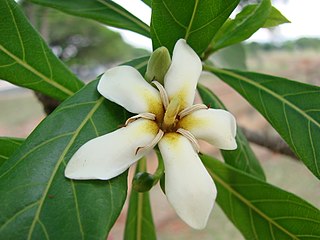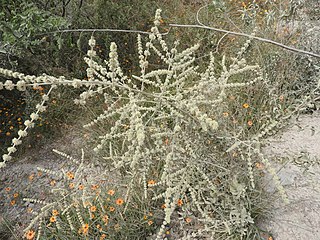
The Rubiaceae are a family of flowering plants, commonly known as the coffee, madder, or bedstraw family. It consists of terrestrial trees, shrubs, lianas, or herbs that are recognizable by simple, opposite leaves with interpetiolar stipules and sympetalous actinomorphic flowers. The family contains about 13,500 species in about 620 genera, which makes it the fourth-largest angiosperm family. Rubiaceae has a cosmopolitan distribution; however, the largest species diversity is concentrated in the tropics and subtropics. Economically important genera include Coffea, the source of coffee, Cinchona, the source of the antimalarial alkaloid quinine, ornamental cultivars, and historically some dye plants.

Genipa americana is a species of trees in the family Rubiaceae. It is native to the tropical forests of North and South America, as well as the Caribbean.

Campanula is one of several genera of flowering plants in the family Campanulaceae commonly known as bellflowers. They take both their common and scientific names from the bell-shaped flowers — campanula is Latin for "little bell".

Ixora coccinea is a species of flowering plant in the family Rubiaceae. It is a common flowering shrub native to Southern India, Bangladesh, and Sri Lanka. It has become one of the most popular flowering shrubs in South Florida gardens and landscapes. It is the national flower of Suriname. Commercially important medicinal plant, used in ayurveda. All parts including flower, leaves and root are taken for various medicinal preparations for skin disease, Diabetes etc

Psydrax odorata, known as alaheʻe in Hawaiian, is a species of flowering shrub or small tree in the coffee family, Rubiaceae. It is native to the Pacific Islands, New Guinea and Australia.

Ruptiliocarpon is a monotypic genus of flowering plants in the family Lepidobotryaceae. The genus has only one species, Ruptiliocarpon caracolito. It is a tall tree that grows in several small isolated areas of Central and South America. It is known from Costa Rica, Colombia, Peru, and Suriname. It is locally common on hillsides and other well-drained areas, often in red clay, from near sea level to 400 m in elevation.

Atractocarpus chartaceus, commonly known as the narrow-leaved gardenia, is a species of evergreen flowering plant in the madder and coffee family Rubiaceae. It is mostly found in subtropical rainforest of eastern Australia, and it is cultivated for its fragrant flowers and colourful fruit.

Pentagonia is a genus of over 40 species of plants in the family Rubiaceae. Pentagonia species are native to Central America and northern South America, and grow in moist tropical forests below 900m. The genus was first described by George Bentham in 1845.
Carex porrecta is a plant species known from Costa Rica, Colombia, Venezuela and Ecuador. It is found in humid forests at elevations of 1,600–2,600 metres (5,200–8,500 ft).

Asterohyptis is a genus of plants in the Lamiaceae, or mint family, first described in 1932. It is native to Mexico and Central America.
- Asterohyptis mocinoana(Benth.) Epling - widespread from Veracruz to Costa Rica
- Asterohyptis nayaranaB.L.Turner - Durango, Nayarit
- Asterohyptis seemannii(A.Gray) Epling - Chihuahua, Sonora, Sinaloa
- Asterohyptis stellulata(Benth.) Epling - from Sinaloa and Durango south to Honduras

Condamineeae is a tribe of flowering plants in the family Rubiaceae and contains about 305 species in 31 genera. Most genera are found in Central and Southern Tropical America, but a few occur in Southeast Asia.
Erigeron irazuensis is a Central American species of flowering plant in the family Asteraceae. It has been found only in Costa Rica.

Solidago brendiae is a species of goldenrod in the family Asteraceae, native to northeastern North America.

Solidago nana is a North American plant species in the family Asteraceae, with the common names baby goldenrod and dwarf goldenrod. The species is native to deserts and mountainsides in the western United States, from the Rocky Mountains to the Great Basin in the states of Idaho, Montana, Nevada, Utah, Wyoming, Colorado, Arizona, and New Mexico.

Xyris jupicai, common name Richard's yelloweyed grass, is a New World species of flowering plants in the yellow-eyed-grass family. It is widespread in North America, South America, Mesoamerica, and the West Indies.

Quercus salicifolia is a species of oak. It is native to central and southern Mexico and Central America, from Jalisco to Panama.

Dr. Charlotte M. Taylor is a botanist and professor specialising in taxonomy and conservation. She works with the large plant family Rubiaceae, particularly found in the American tropics and in the tribes Palicoureeae and Psychotrieae. This plant family is an economically important group, as it includes plant species used to make coffee and quinine. Taylor also conducts work related to the floristics of Rubiaceae and morphological radiations of the group. Taylor has collected plant samples from many countries across the globe, including Chile, Colombia, Costa Rica, Panama, and the United States of America, and has named many new species known to science from these regions. As of 2015, Taylor has authored 278 land plant species' names, the seventh-highest number of such names authored by any female scientist.

Palicourea elata, formerly Psychotria elata, commonly known as girlfriend kiss and labios de puta, is a tropical plant that ranges from Central to South American rain forests in countries such as Mexico, Costa Rica, Ecuador, Panama, and Colombia. Palicourea elata is extremely sensitive and requires specific climates to grow, those climates most like rainforests are best suitable for this plant. It is most notable for its distinctly shaped red bracts and is consequently nicknamed “Hot Lips”. Though the bright red bracts are considered its most flashy feature, they are not the actual flowers of the plant but instead extravagant leaves; the flowers of Palicourea elata lie within the “red lip” leaves. Just like human lips, the hot lips plant comes in a variety of shapes and forms offering a vast array of plants. P. elata is well-studied and has been documented over centuries to provide various health benefits to native communities. Due to these benefits and the overall appearance of the plant, it has been over-harvested and is now endangered.

Symphyotrichum estesii is a species of flowering plant in the family Asteraceae, endemic to Coffee County, Tennessee. Commonly called May Prairie aster and Estes's aster, it is a perennial, herbaceous plant that may reach 30 to 85 centimeters in height. Its flowers have white ray florets and yellow disk florets. It is named in honor of botanist Dwayne Estes who discovered it in 2008.

Podranea ricasoliana, called the pink trumpet vine, is a species of flowering plant in the genus Podranea, native to South Africa, Malawi, Mozambique and Zambia. It has gained the Royal Horticultural Society's Award of Garden Merit.
















